
Fundamentals
The concept of African Cranial Shaping extends far beyond a mere physical characteristic; it delves into the very ancestral bedrock of identity, well-being, and community, particularly as it relates to the vibrant world of textured hair. To understand its fundamental meaning, we must first look to the profound ways in which African peoples, throughout history, have perceived and honored the head as a sacred locus of being. This perspective encompasses not only the natural variations in skull form but also the intentional cultural practices that have subtly or overtly influenced head contours, all inextricably linked to the styling and care of the hair that crowns it.
At its simplest, African Cranial Shaping can be viewed as the indigenous understanding and engagement with the form of the human head, recognizing its biological predispositions while simultaneously acknowledging its malleability and symbolic significance within cultural contexts. This understanding was never divorced from the hair that emerged from the scalp; indeed, the head and its hair were often considered an indivisible unit, a canvas for spiritual expression, social markers, and aesthetic declaration. The shape of the skull, whether naturally occurring or modified through ancestral practices, directly influenced how hair was styled, adorned, and revered. This deep connection served as a foundational element in daily life and ceremonial rituals, underpinning a rich tradition of hair care that spanned generations.
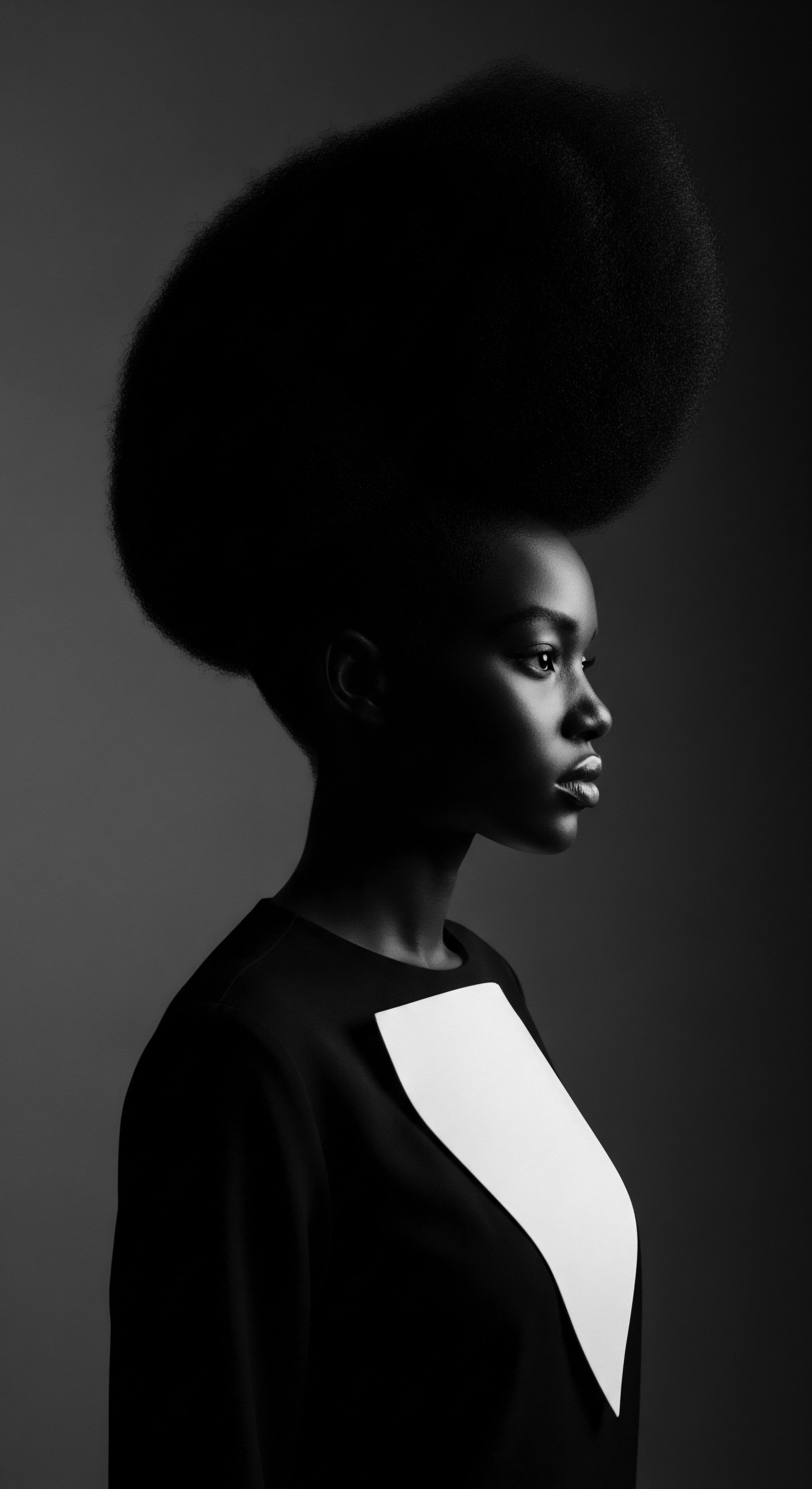
The Head as a Sacred Foundation
In many African societies, the head held a profound position as the seat of the soul, wisdom, and destiny. For the Yoruba people, for example, the concept of Ori, specifically Ori-Inu (the inner head), represents one’s spiritual essence and personal destiny. This spiritual entity, residing within the physical head, was believed to guide an individual’s life journey. Thus, maintaining the physical head and its hair in a state of honor and balance was paramount.
These beliefs underscore why practices related to the head, including its perceived shape and the care of its hair, were never merely cosmetic. They were deeply spiritual engagements, acts of reverence for one’s inherent self and connection to the divine. The tangible shape of the head, whether an ancestral trait or a result of communal shaping practices, therefore, became a visible manifestation of inner realities, intertwined with the very fiber of one’s being and the unique characteristics of textured hair.
African Cranial Shaping refers to the indigenous understanding and practices surrounding the form of the human head, recognizing its biological contours, cultural modifications, and profound symbolic connection to textured hair and identity.
The earliest understandings of cranial shaping in an African context were likely observational, noting the natural variations in skull shapes that occur across populations. However, these observations quickly gained cultural overlays. Communities began to associate certain head forms with particular lineage, status, or even desired characteristics.
This led to the development of practices aimed at accentuating or subtly altering head contours, often beginning in infancy when the cranial bones retain their plasticity. These intentional practices were invariably complemented by specific hair styling techniques, designed to either highlight the achieved head shape or create an illusion of a desired form, making the hair an active participant in the visual articulation of identity.
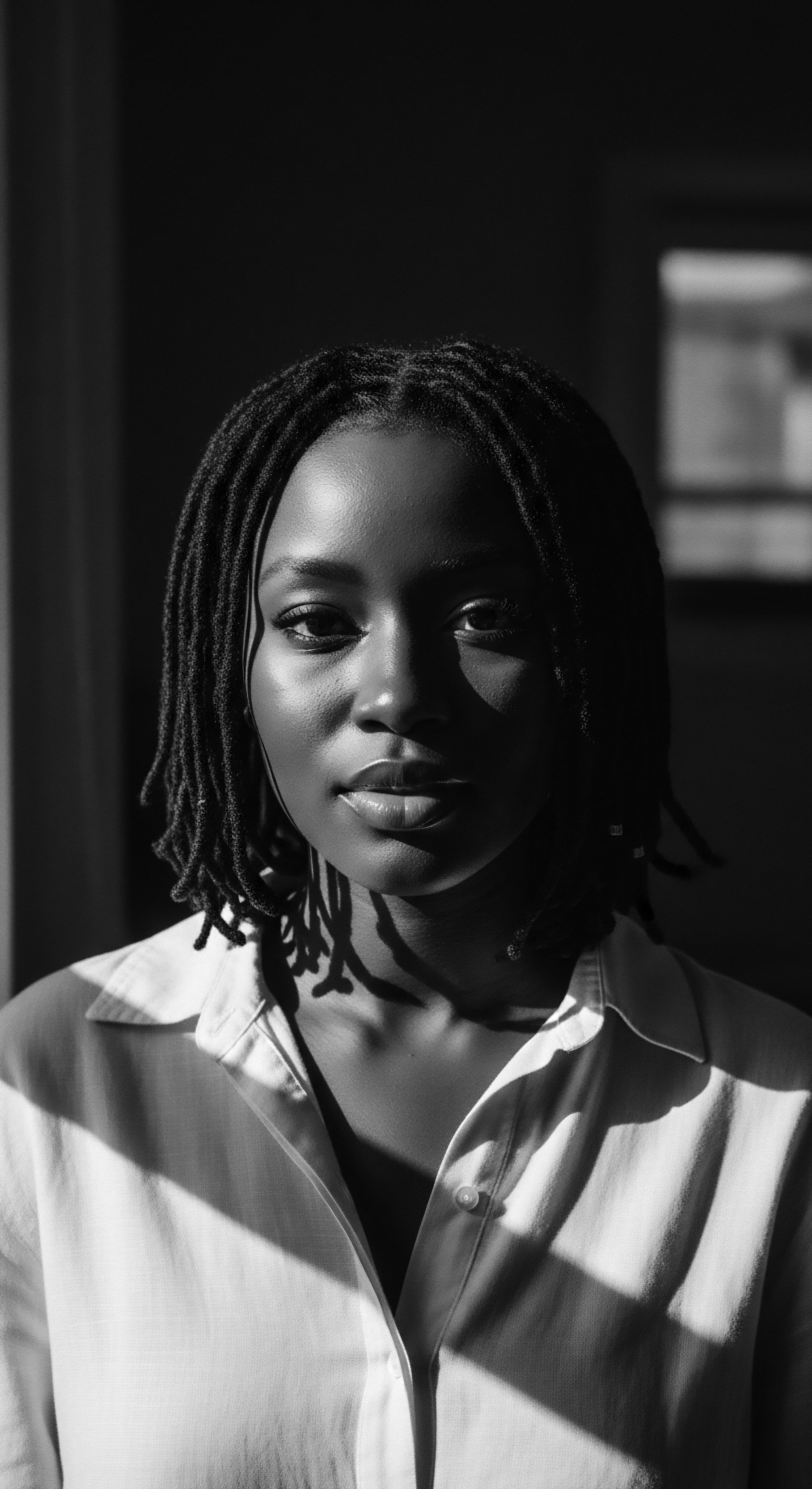
Early Connections to Hair Texture
The distinctive characteristics of textured hair, from tight coils to broader waves, are inherently linked to the shape of the hair follicle itself. Research indicates that African hair is almost universally curly, a trait strongly associated with follicles that possess a curved shape. This natural biological reality meant that ancient African communities developed hair care practices uniquely suited to these resilient, yet delicate, hair structures. Scalp health and hair strength were prioritized, with traditional oils, butters, and herbs forming the backbone of care rituals.
The way hair sat on the head, its volume, and its ability to hold intricate styles were all influenced by the underlying cranial structure. These early communities possessed an intuitive understanding of this interplay, allowing their hair care and styling to adapt to and celebrate the inherent form of their heads. The act of styling, therefore, became a dialogue between the natural growth patterns of textured hair and the perceived or actual shape of the skull, a conversation carried through generations of hair knowledge.
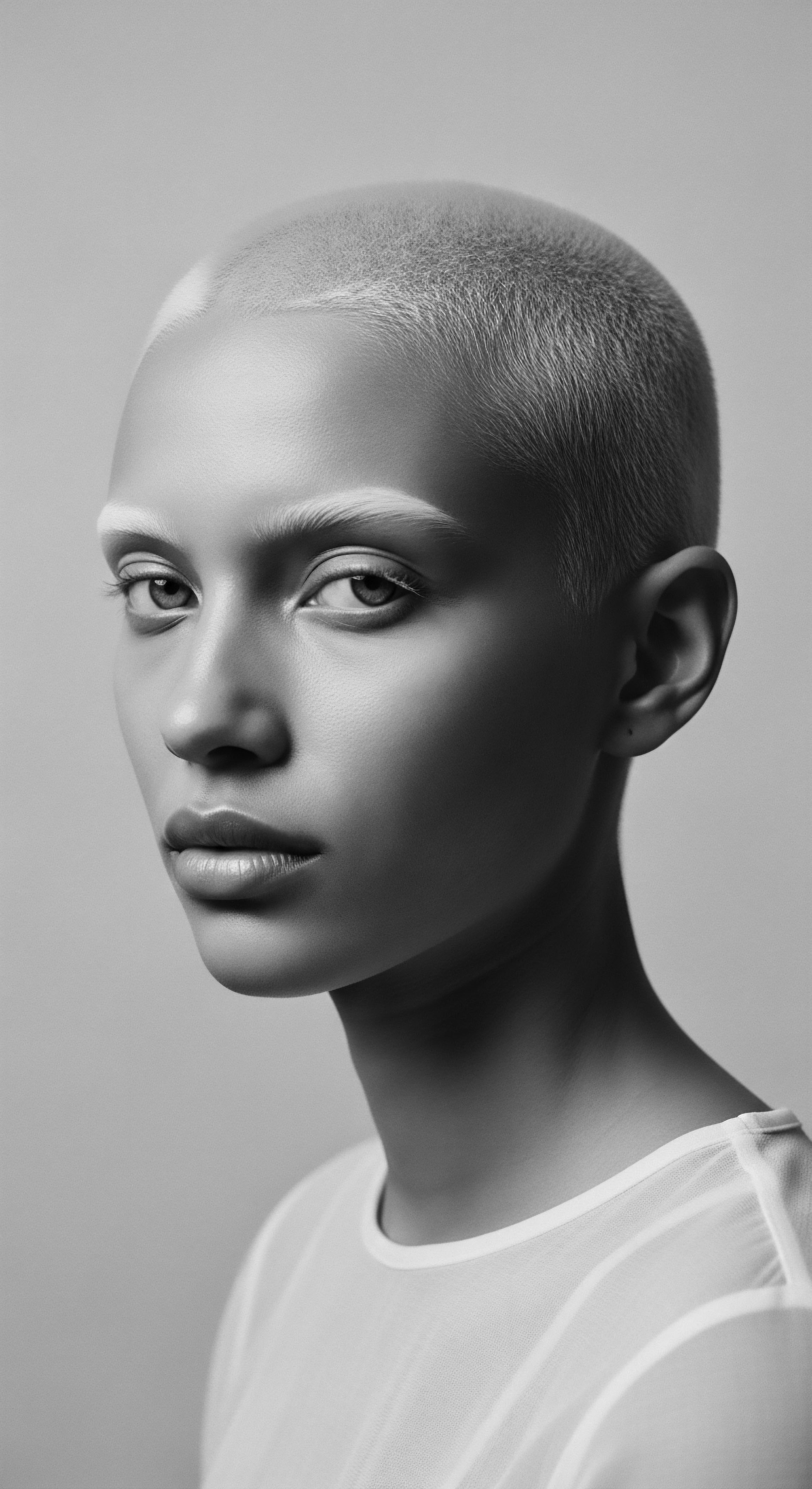
Intermediate
The concept of African Cranial Shaping, when examined through a more intermediate lens, extends beyond basic recognition into its functional and expressive dimensions within heritage practices. This involves exploring the nuanced ways in which ancestral communities not only understood the physical dimensions of the head but actively engaged with them, often through practices that intertwined deeply with the cultivation and presentation of textured hair. This intermediate analysis recognizes that the ‘shaping’ was seldom about rigid, enforced alteration, but rather a spectrum of influences, from the subtle effects of generational hair practices on scalp health to more direct, yet gentle, methods of accentuating desired cranial aesthetics.
Historical evidence suggests that the symbolic power of the head in African societies was profound. It often represented one’s spiritual connection, lineage, and social standing. This reverence led to diverse cultural expressions, with hair becoming a primary medium for communicating these deeply held values.
The practices associated with African Cranial Shaping, in this context, encompass the collective wisdom regarding optimal scalp conditions, the integration of hair texture into culturally significant styles, and the communal rituals that reinforced the bond between a person’s head, their hair, and their heritage. It is a testament to the sophistication of ancestral knowledge, where every strand and every curve of the head carried meaning.
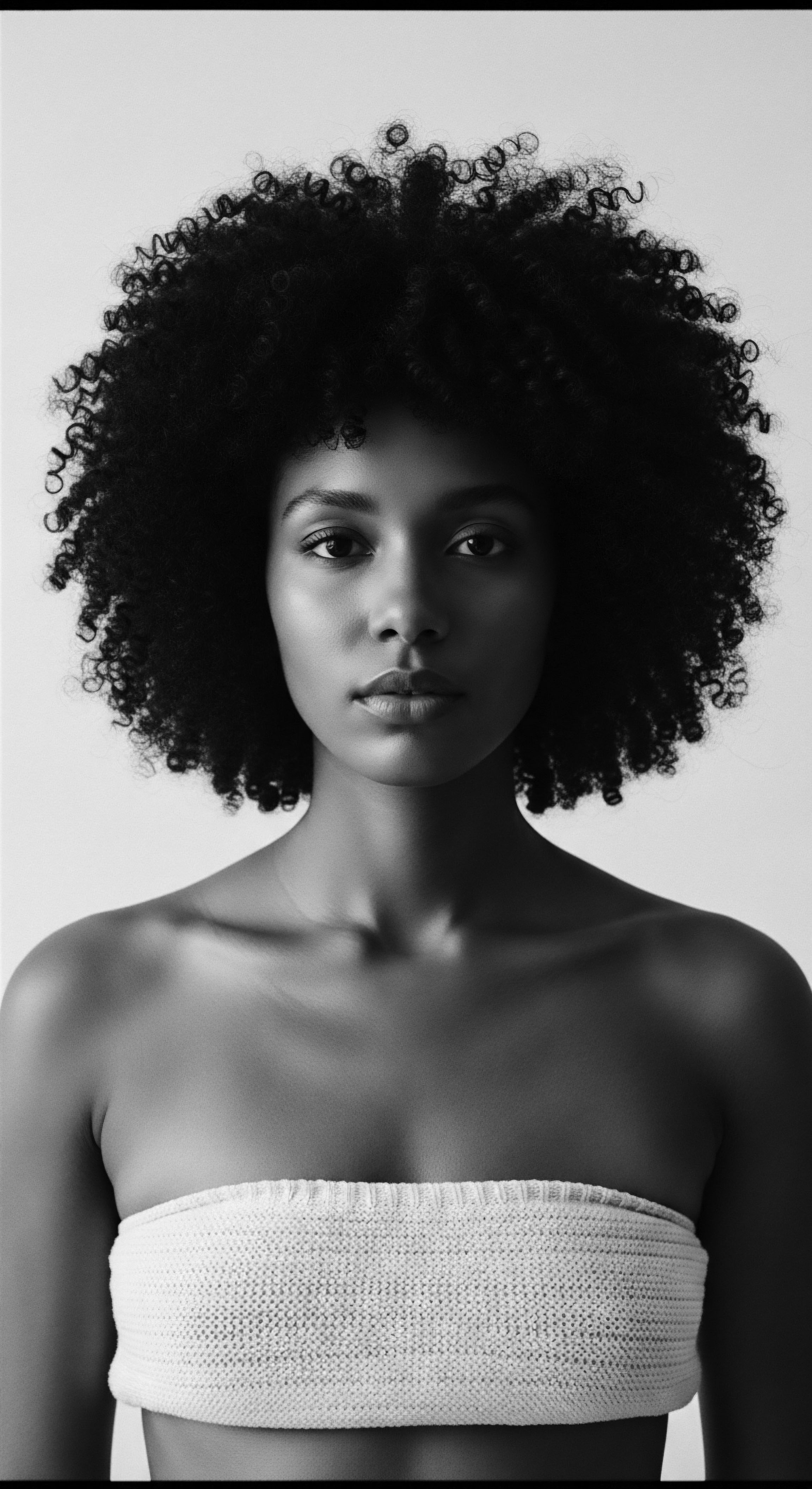
Cultural Delineations and Hairstyles
Across the African continent, head coverings and hairstyles served as intricate languages, conveying complex messages about an individual’s marital status, social hierarchy, age, and tribal affiliation. The inherent shape of the head, whether naturally round, elongated, or otherwise, provided the foundation upon which these stylistic narratives were built. In communities where specific head shapes were admired, hair styling techniques would often be employed to enhance or complement these features.
For instance, high updos, elaborate braids, or specific coiffures could create the visual impression of an elongated head or a broader forehead, even in the absence of intentional cranial modification. These styles were not merely decorative; they were living archives of cultural identity and heritage.
The interplay between cranial structure and hair styling is a profound testament to ancestral ingenuity. Early observations of hair growth patterns and the natural contours of the head led to hair practices that honored these biological realities while still achieving culturally desired aesthetics. Traditional hair tools, such as wide-toothed combs crafted from natural materials, and the use of natural oils and butters for scalp health and moisture, were developed with textured hair’s unique properties in mind.
These practices not only maintained hair health but also served as communal rituals, passed down through generations, strengthening familial bonds and preserving collective wisdom. The act of braiding, for example, often involved working with the natural curvature of the scalp, creating patterns that celebrated the head’s form.
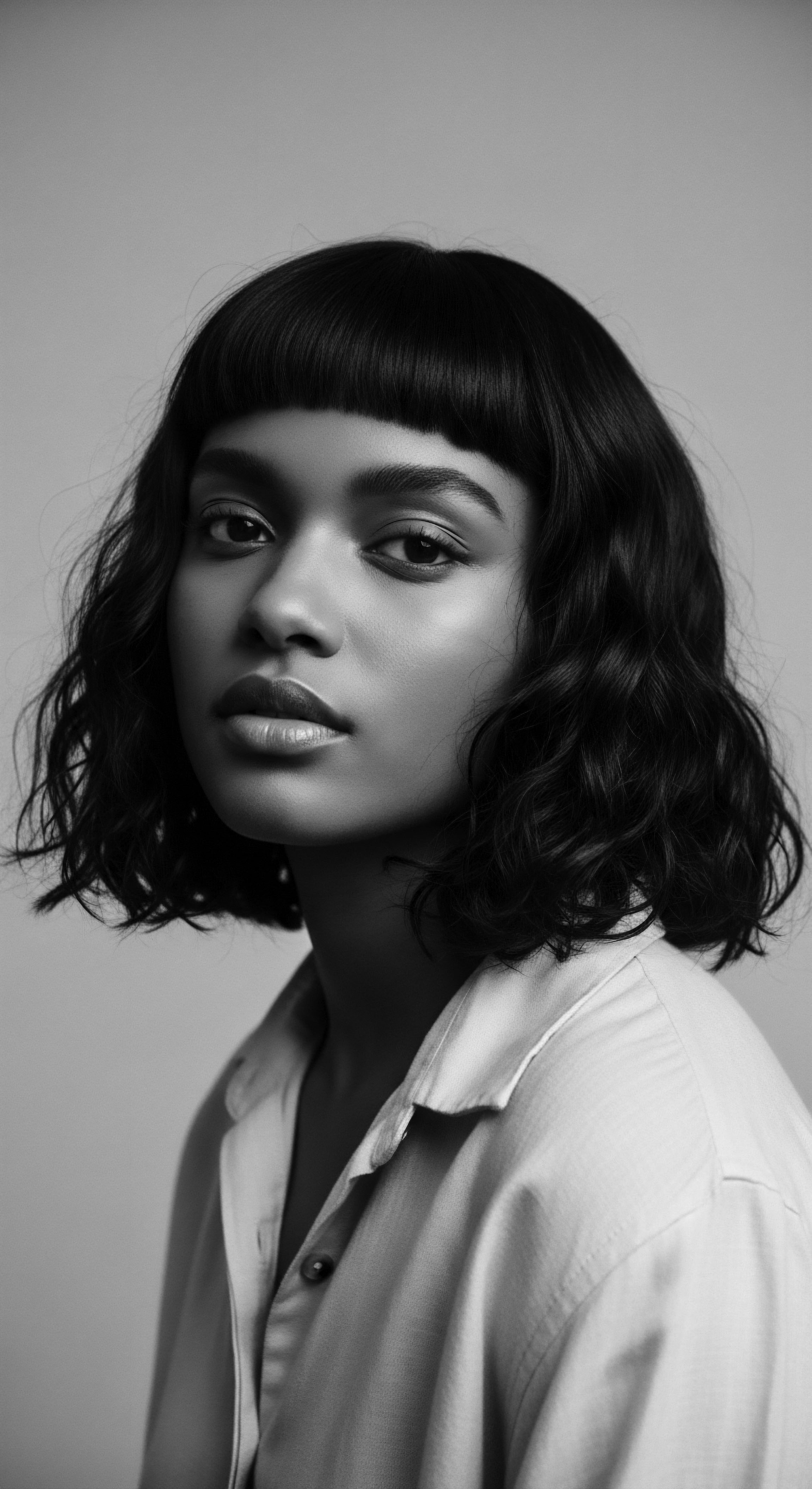
Scalp Health and Ancestral Rituals
Integral to the holistic understanding of African Cranial Shaping is the deep-seated ancestral knowledge of scalp health. A healthy scalp is the very ground from which hair grows, and traditional African hair care rituals placed immense importance on nourishing this vital area. Practices such as scalp oiling, known in many African traditions, utilized indigenous oils and butters like Shea Butter and Castor Oil to moisturize the scalp, seal in hydration, and promote robust hair growth.
These rituals were often communal, involving family members, particularly elders, who shared their wisdom and techniques. This consistent care over a lifetime, passed down through generations, could subtly influence the overall health and presentation of hair on the head, leading to what we might call a natural shaping of the hair-head complex.
- Chebe Powder ❉ Originating from Chad, this blend of herbs (including lavender crotons, cloves, and cherry seeds) is renowned for its ability to increase hair thickness and enhance moisture retention, directly contributing to the health of the scalp and hair.
- Shea Butter ❉ Widely used across West Africa, this natural fat from the shea tree conditions both hair and scalp, providing deep moisture and acting as a protective barrier against environmental stressors.
- African Black Soap ❉ Traditionally used for cleansing, its gentle yet effective properties for both skin and scalp illustrate an ancestral understanding of natural purification, fostering a healthy environment for hair growth.
Ethnobotanical studies highlight the extensive use of local flora for hair and scalp care across Africa. In Afar, Northeastern Ethiopia, for instance, a study identified 17 plant species used for hair and skin care, with Ziziphus Spina-Christi and Sesamum Orientale leaves being among the most preferred for hair cleansing and conditioning. Such deep integration of plant wisdom into daily routines demonstrates an ancient science of scalp nutrition that supported the health and appearance of hair, intrinsically linked to the living canvas of the head. This meticulous attention to scalp health allowed for the resilience and versatility of textured hair, enabling the diverse array of styles that were a hallmark of African identity.
| Ingredient Aloe Vera |
| Traditional Use Soothing, moisturizing, wound healing. |
| Connection to Cranial Shaping / Hair Health Applied to the scalp for hydration, reducing irritation that could impede healthy hair growth and overall scalp well-being. |
| Ingredient Baobab Oil |
| Traditional Use Nourishing, protective, adds elasticity. |
| Connection to Cranial Shaping / Hair Health Supports hair strength, reducing breakage and enabling healthy length, complementing the natural contours of the head. |
| Ingredient Neem Oil |
| Traditional Use Anti-fungal, anti-bacterial, addresses scalp conditions. |
| Connection to Cranial Shaping / Hair Health Maintains a clean, healthy scalp environment, vital for hair growth that honors the integrity of the head's surface. |
| Ingredient These ancestral ingredients offer profound nourishment for the scalp and hair, reflecting a deep respect for the head as the source of vitality. |

Academic
The academic meaning of African Cranial Shaping represents a synthesis of anthropological inquiry, biological understanding, and historical context, moving beyond superficial observations to dissect its multifaceted interplay with textured hair heritage. This concept is not merely a descriptive term for head forms; it encapsulates the profound and often intimate relationship between cranial morphology—both naturally occurring and culturally influenced—and the diverse expressions of hair and identity within African and diasporic communities. It demands a rigorous examination of how ancient knowledge systems, often dismissed by Western reductionism, contributed to a sophisticated understanding of the human head as a living entity, capable of both natural variation and intentional, culturally significant modification.
The examination of African Cranial Shaping necessitates a deep dive into the evolutionary biology of human hair, particularly the tightly coiled hair predominant in many African populations. Such hair, associated with distinctly curved hair follicles, is hypothesized to offer thermoregulatory advantages in high-solar environments, reducing heat gain on the scalp. This fundamental biological adaptation laid the groundwork for cultural practices that not only accommodated but celebrated this unique hair texture, shaping hair traditions around its inherent properties and the underlying cranial architecture.
The scientific perspective acknowledges that human hair variability is a consequence of adaptive pressures experienced by populations after dispersing from Africa. Thus, the cranial form and hair texture are intrinsically linked through evolutionary heritage.
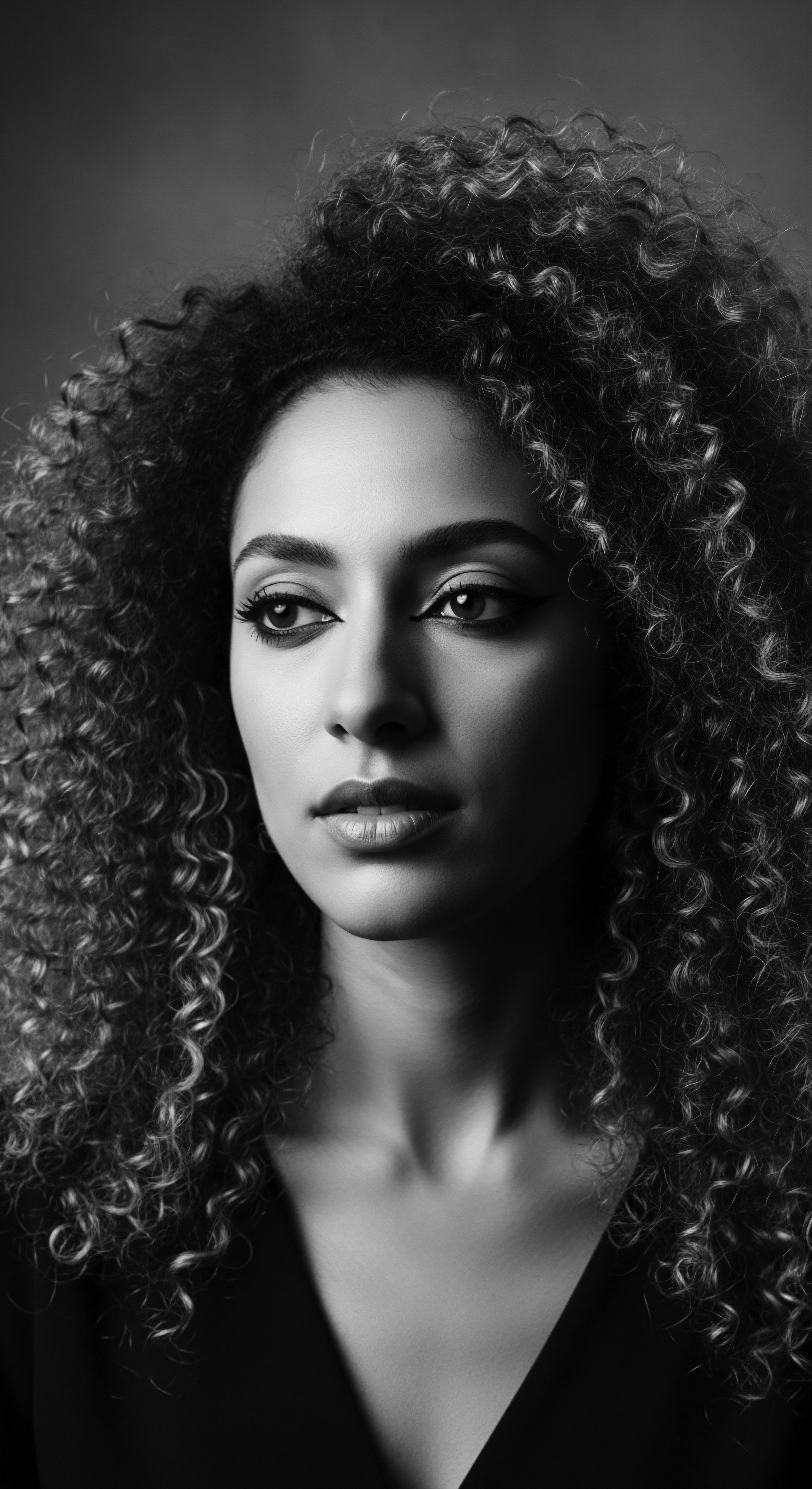
Phenotypic Plasticity and Cultural Modification
While genetic factors largely dictate natural cranial morphology and hair texture, the concept of African Cranial Shaping extends to practices of intentional cranial modification. This ancient practice, known as artificial cranial deformation, occurred globally, but its manifestations and cultural significances varied widely. In certain African societies, it was a deliberate act, often beginning in infancy, when the cranial bones are still pliable. These modifications, such as the elongation of the skull, were not arbitrary; they were laden with specific cultural meaning, signifying status, beauty, wisdom, or tribal affiliation.
The resulting head shape became a tangible marker of identity, influencing societal perceptions and aesthetic ideals. Such practices underscore the human capacity to interact with and subtly reshape biological form in alignment with cultural values.
A compelling case study that powerfully illuminates the African Cranial Shaping’s connection to textured hair heritage and ancestral practices comes from the Mangbetu People of the northeastern Democratic Republic of Congo. Historically, the Mangbetu practiced Lipombo, a form of intentional cranial elongation. This process involved tightly wrapping the heads of infants with cloth from birth for several years, gradually molding the skull into a distinctive elongated shape. This custom was not merely an aesthetic choice; it held profound significance, denoting majesty, beauty, power, and higher intelligence within the Mangbetu ruling classes.
The Mangbetu practice of Lipombo, or intentional cranial elongation, exemplifies how African communities intertwined head morphology with identity, social standing, and unique hair aesthetics.
The crucial connection to hair heritage lies in how these elongated cranial forms were then emphasized and celebrated through specific coiffures. Adult Mangbetu individuals, particularly women, would style their textured hair around woven basket frames to further accentuate the elongated head shape, creating an even more striking visual. This synergy between modified cranial form and elaborate hair styling demonstrates a deeply integrated understanding of the head as a holistic canvas for cultural expression. The hair was not simply an accessory to the head; it was an active participant in defining the sculpted cranial aesthetic, becoming an extension of the intentional shaping process.
This practice, though it began to decline in the 1950s due to colonial outlawing and Westernization, serves as a poignant reminder of the intricate ways ancestral communities used both biological and cultural means to voice identity and heritage through the morphology of the head and its hair. The legacy of Lipombo remains an unparalleled historical example of African Cranial Shaping as a deliberate act of cultural artistry and social demarcation.
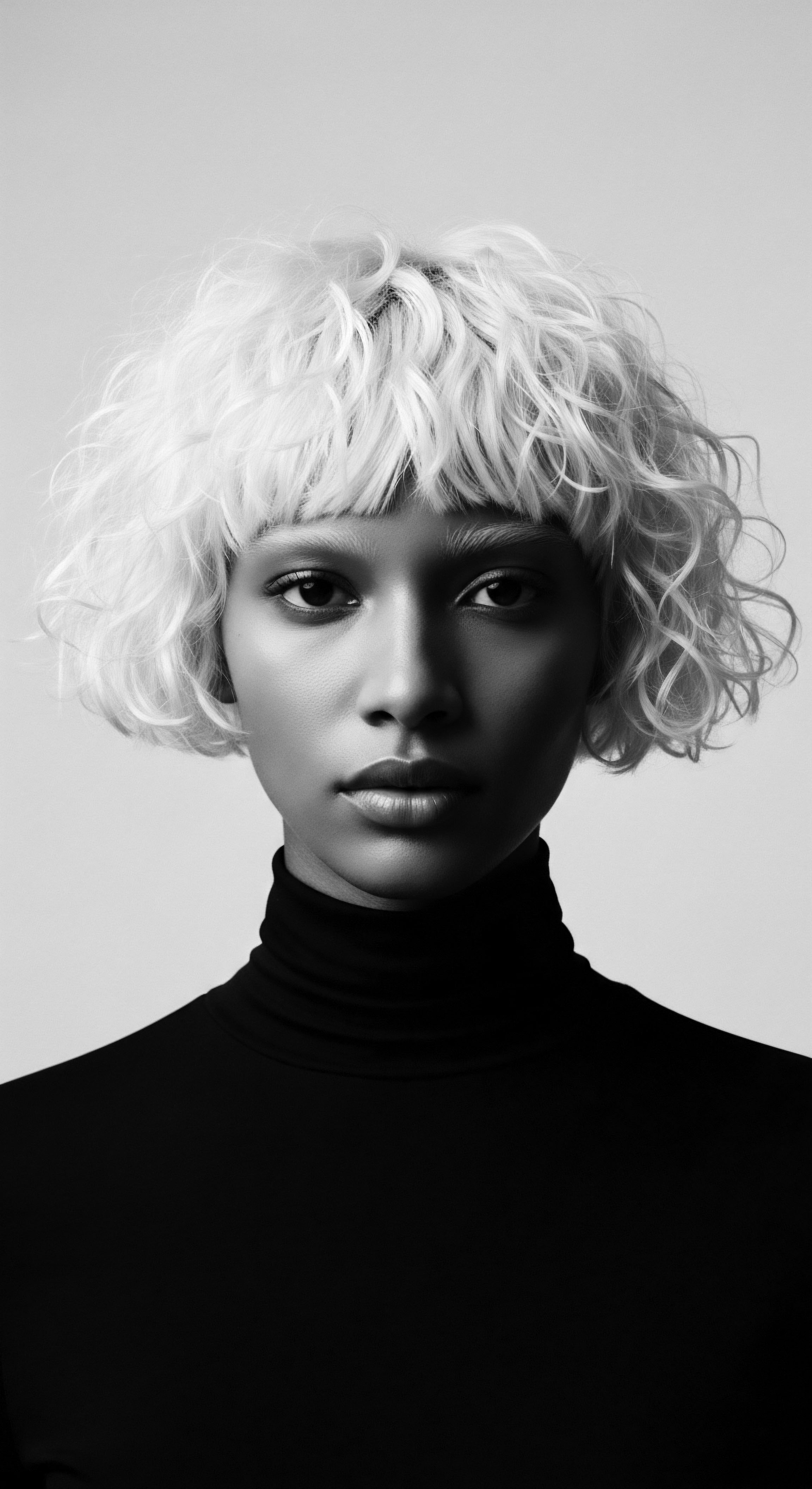
Ancestral Care and Bio-Cultural Resilience
Beyond intentional shaping, African Cranial Shaping encompasses the continuous, often subconscious, influence of traditional hair care practices on scalp and hair health, which in turn affect the appearance of the head. The ancestral understanding of textured hair’s unique structural properties—its elliptical cross-section and tendency towards fragility due to curvature—led to care rituals prioritizing moisture, protection, and gentle handling. These practices, including regular scalp massages and the application of natural butters and oils, not only promoted hair growth and scalp vitality but also contributed to a holistic sense of well-being, deeply rooted in a reverence for the body’s natural state.
For example, the meticulous scalp oiling rituals found across West African traditions kept hair moisturized in dry climates and were often paired with protective styles to preserve length and health, underscoring a sophisticated, long-term approach to hair care intimately tied to the head’s environment. Such sustained care over generations can be seen as a form of “shaping” the environment around the scalp to support optimal hair health, fostering a bio-cultural resilience in the face of environmental challenges and external pressures.
The academic exploration also considers the impact of colonial legacies on perceptions of African cranial and hair aesthetics. Historical accounts reveal that during the slave trade, captured Africans were often forced to shave their hair as a means of humiliation and stripping identity, a direct assault on the deep cultural value placed on African hair. Post-colonial narratives further perpetuated notions that natural African hairstyles were “ancient and unprofessional,” forcing many to conform to European beauty standards through chemical straightening.
This historical trauma highlights how external forces attempted to “re-shape” the meaning of African cranial and hair aesthetics, yet the inherent resilience of cultural practices persisted, finding new forms of expression and affirmation in the diaspora. The CROWN Act in California, making discrimination based on natural hair illegal, represents a contemporary effort to reclaim and affirm the cultural significance of Black hair, linking back to ancestral values of authenticity and pride.

Genetics, Morphology, and Adaptations
From a biological standpoint, the variations in human hair texture, particularly the tightly coiled forms common in African populations, are linked to genetic factors influencing keratin structure and hair follicle morphology. Studies in human biology have observed distinct variations in certain KAP Cluster Genes present in African populations that are largely absent elsewhere, suggesting environmental or sexual selective pressures influenced hair type after human dispersion from Africa. The high curvature of African hair follicles, resulting in an asymmetrical S-shaped structure, makes textured hair more prone to damage compared to other hair types.
This inherent fragility, however, has historically led to the development of highly protective and nourishing hair care traditions rather than a perception of “bad” hair. The ancestral knowledge of these biological realities informed methods of care that minimized breakage and promoted scalp health, ensuring the longevity and vitality of hair that complemented the head’s form.
The academic lens further examines how ancestral practices, often rooted in ethnobotany, provide sophisticated solutions for hair and scalp health. A review of African plants used for hair treatment identifies 68 species employed for conditions like alopecia and dandruff, with many also demonstrating potential antidiabetic properties when taken orally, suggesting a holistic connection between scalp health and systemic well-being. For instance, a study in Northern Morocco identified 42 plant species traditionally used for hair care, with Lawsonia Inermis (henna) being a prominent example for its conditioning and protective qualities. This wealth of botanical knowledge represents an empirical science, passed down through generations, focused on sustaining the scalp environment and hair fibers in harmony with the natural cranial landscape.
- Historical Hair Oiling ❉ The practice of scalp oiling, a cornerstone of African hair care, has ancient roots, with oils like shea butter and castor oil used to seal in moisture and promote hair growth, crucial for textured hair in diverse climates.
- Protective Styling ❉ Techniques such as intricate braids and cornrows, dating back thousands of years in African cultures, not only carried social and spiritual meaning but also protected the hair from environmental damage, aligning with the contours of the head.
- Community Hair Rituals ❉ Hair care often functioned as a communal activity, particularly among women, fostering intergenerational knowledge transfer and reinforcing social bonds, all centered around the head as a symbol of shared identity and heritage.
| Aspect Scalp Massage |
| Ancestral Understanding / Practice Routine hand massage to stimulate growth and soothe the scalp. |
| Contemporary Scientific Insight Improves circulation to hair follicles, promotes thicker hair, and may reduce hair loss. |
| Aspect Natural Ingredients |
| Ancestral Understanding / Practice Extensive use of indigenous plants (e.g. Ziziphus spina-christi, Amla, Hibiscus) for cleansing, conditioning, and treatment. |
| Contemporary Scientific Insight Validation of therapeutic compounds (e.g. antioxidants, anti-inflammatory properties) that nourish scalp and hair. |
| Aspect Hair Follicle Shape |
| Ancestral Understanding / Practice Implicit understanding that African hair is distinct, requiring unique handling and protective styles. |
| Contemporary Scientific Insight Identified as elliptical with a curved shape, making hair more prone to dryness and breakage, validating the need for specialized care. |
| Aspect The enduring wisdom of ancestral African hair care practices, often intuitively linked to cranial well-being, finds compelling validation in modern scientific understanding, bridging past and present. |

Reflection on the Heritage of African Cranial Shaping
The journey through the meaning of African Cranial Shaping reveals a rich tapestry woven from ancestral wisdom, cultural resilience, and the enduring beauty of textured hair. This concept is not confined to static historical facts or mere biological attributes; it is a living, breathing archive of human ingenuity and profound connection to self. It reminds us that for countless generations, African peoples approached the head as a sacred crown, the very essence of identity, and the hair that flourished from it as a potent symbol of lineage, community, and spirit. The intentional shaping of the skull in certain traditions, like the Lipombo of the Mangbetu, and the universal practices of nurturing scalp and hair, demonstrate a deep respect for the physical form as a medium for cultural expression.
As we navigate the contemporary landscape of hair care and identity, the echoes of African Cranial Shaping continue to resonate. The resilience seen in Black and mixed-race hair experiences, often against historical pressures to conform to Eurocentric beauty standards, speaks to the strength of this inherited wisdom. Each coil, kink, and curl carries a story, a memory of ancestral hands that understood the delicate balance of scalp health, moisture, and protective styling. The resurgence of natural hair movements globally is a powerful affirmation of this heritage, a collective reclamation of self-worth that begins with honoring the hair and the head as they naturally are, or as they were historically shaped by cultural pride.
This enduring connection to the heritage of African Cranial Shaping inspires us to look beyond fleeting trends and commercial promises, inviting us to rediscover the deep, intuitive knowledge of our forebears. It encourages us to see hair care as a holistic practice, a ritual of self-love and connection to ancestry. By understanding the intricate relationship between the head’s form and the hair’s texture, we honor the ancestral practices that sustained generations and continue to offer a pathway to authentic well-being. The legacy of African Cranial Shaping is a testament to the fact that true beauty often blossoms from a profound appreciation for one’s own unique, inherited landscape, from the very top of the head to the deepest roots of identity.

References
- Omotos, Adetutu. “Hair and Identity in Ancient African Civilizations.” Journal of Pan African Studies, 2018.
- Katsande, Rukariro. “The Significance of Head Ties in Africa.” Wilderness, 2015.
- Sherrow, Victoria. Encyclopedia of Hair ❉ A Cultural History. Greenwood Publishing Group, 2006.
- Muthukrishnan, Eaaswarkhanth, et al. “A Curious Reader asks ❉ Why do some people have curly hair and others straight?” Human Biology, 2018.
- Jablonski, Nina G. and George Chaplin. “The Evolution of Skin Pigmentation and Hair Texture in People of African Ancestry.” Human Biology, 2014.
- Iannaccone, Alessandra, et al. “Black women’s hair ❉ the main scalp dermatoses and aesthetic practices in women of African ethnicity.” Anais Brasileiros de Dermatologia, 2020.
- Mouchane, Mohamed, et al. “Ethnobotanical Survey of Medicinal Plants used in the Treatment and Care of Hair in Karia ba Mohamed (Northern Morocco).” Journal of Medicinal Plants and By-products, 2023.
- Ngokou, Albert-Pascal, et al. “Cosmetopoeia of African Plants in Hair Treatment and Care ❉ Topical Nutrition and the Antidiabetic Connection?” MDPI Diversity, 2024.
- Khumalo, Ncoza D. et al. “The Genomic Variation in Textured Hair ❉ Implications in Developing a Holistic Hair Care Routine.” MDPI Cosmetics, 2022.
- Hiernaux, Jean. “Differentiation of modern sub-Saharan African populations ❉ craniometric interpretations in relation to geography and history.” Journal of African Archaeological Review, 1976.
